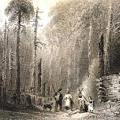 Because of the harsh climate that the settlers encountered, the location of their first shelter was paramount. Building materials were not a problem in the dense virgin forest. The first shelter that was built was usually a crude and cramped log cabin. It was built of newly felled trees, which were still covered with bark.
Because of the harsh climate that the settlers encountered, the location of their first shelter was paramount. Building materials were not a problem in the dense virgin forest. The first shelter that was built was usually a crude and cramped log cabin. It was built of newly felled trees, which were still covered with bark.
Oxen were used to haul the heavy logs into place. When the walls were up, the roof was set in place. Basswood logs, split in half and easily hollowed, provided the best means of weather protection. They were placed overlapping, with one level curved up, the next curved down so that they fit together like tiles. Openings between were packed with moss, then plastered with mud or clay. This type of roof shed the water perfectly. Moss and clay were also used to fill the spaces between the logs forming walls.
Inside the cabin, the floor was earth. At the north end of the cabin, a chimney of fieldstone chinked with clay was built. A large open fireplace furnished a place to cook. The same fire would keep the family warm during the cold winter months. One window was always set to the south for warmth and light from the sun. Crude shutters closed the opening. If panes of glass had been brought, then one or two windows would have them.
Early Furnishings:
Every bit of wood brought by the settlers on their journey to the new land was used to make furnishings. These were roughly made, often by unskilled hands. A primitive table of boards, supported by crutches driven into the ground, began the furnishings. Next was the bed, which was set in the corner and supported by cut poles driven into the earth floor. Elm bark, stripped from the trees into proper widths and woven around the poles rather like a basket, completed the structure. This piece of furniture was called a "catamount bedstead" and had storage space underneath. Any bedding brought by the settlers was then used.
The Second or Third Year: The Cabin Is Improved:
The first major improvement to the log cabin was the digging of a cellar and the making of a wooden floor. This had to be done by hand if there was still no sawmill in the vicinity. Frozen logs were cut lengthwise and laid across the floor. When the boards had thawed out, the resulting expansion of the wood made the floorboards very tight. The doors and partitions were made of hand hewn planks fastened together by dowels or wooden pegs, and leather was used for hinges. If a blacksmith was available, iron nails, hinges, latches, and other essential items could be bought from him. With the installation of wooden floors, the furniture was now able to be improved.
Livestock Fenced In:
Cedar trees were cut, stripped, and split. As quickly as possible, these were used to fence in the enclosures for the livestock. Shelters to protect the animals were also built. Hollowed logs were used for feed and water troughs.
Clearing the Land:
The next task was to clear the land around the cabin and animal shelters. Gradually as the forest was pushed back, the sunshine was able to penetrate, which helped warm the cabin and make it less damp. Trees were felled, stumps were dragged out of the ground, and the ever-present rocks were removed from the soil. Clearing the land was a long, arduous task.
Potash:
As the settlers cleared their land for farming, they had the opportunity to make money by selling potash made through the burning of stumps and roots. Potash was their first cash crop as they settled on the new land. It was carefully collected and stored in barrels, which would be hauled to market.
The First Planting:
Survival depended on planted seed. The Indians knew what crops grew well in the North American climate. Most of the crops were introduced to the first European settlers by the Indians. However, it was not unusual for this harvest to prove a failure whether through the ravaging of bears or destruction by frost.
The first year, potatoes, squash (pumpkins),beans, corn, and a few other vegetables were raised around the stumps of the trees, while the burning of stumps and tearing of tree roots from the land continued. The yoke of oxen continued to prove their value. It was not until the second or third year that enough grain was raised to furnish all of the family needs.
The Pioneers Made Use of the Food Around Them:
The early settlers were able to hunt and trap. Wild duck, goose, partridge, rabbit, and deer were plentiful. Venison provided a hearty meal. The main part was dried and kept for winter supplies.
Using snowshoes to tend the trap lines in winter, the settlers could find food for the taking. The Indians were friendly and presented no threat to their safety. Skins from the animals were tanned in a primitive way and used for clothing, moccasins, or for patching clothes.